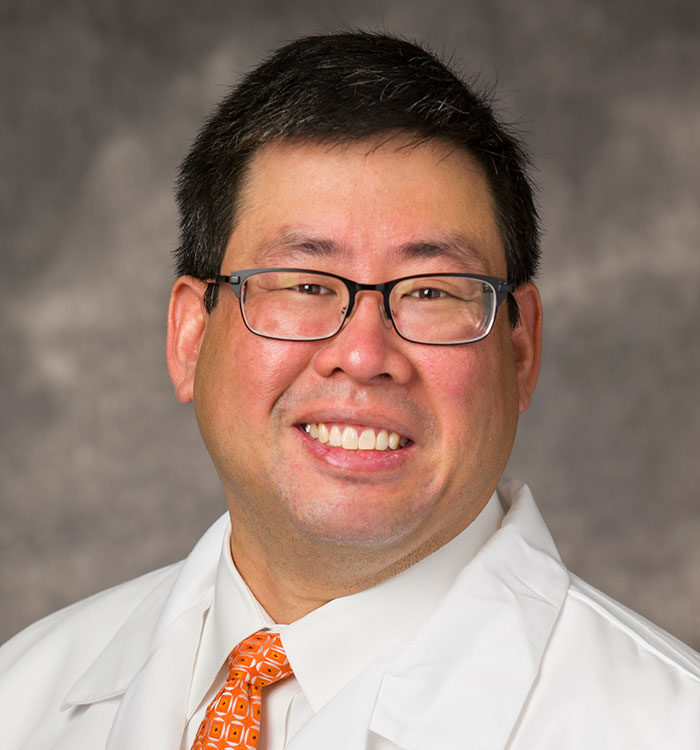Coronary CTO Program at University Hospitals Outperforms National Averages
December 06, 2023
Innovations in Cardiovascular Medicine & Surgery | Fall 2023
Expert interventional cardiologists at University Hospitals Harrington Heart & Vascular Institute are revascularizing coronary chronic total occlusions (CTOs) with an 86 percent success rate and a major adverse cardiac arrest events (MACE) rate of less than one percent.
 Paul Poommipanit, MD
Paul Poommipanit, MD“CTOs present a more complex echelon of coronary revascularization and historically required bypass surgery,” says Paul B. Poommipanit, MD, Director of the Coronary Chronic Total Occlusion Program and Co-Director of the CHIP and High-Risk Coronary Program within UH Harrington Heart & Vascular Institute.
The past 10 to 15 years have seen a progression of percutaneous coronary intervention (PCI) techniques to revascularize CTO. “Operators around the country have increased their knowledge and skillset to address these occlusions to the point where we can open the blockage the vast majority of the time,” says Dr. Poommipanit. “However, one challenge has been post-procedural complications.” Although large registries of traditional stent implantation indicate a complication rate of less than 1 percent, national MACE rates for CTO procedures average three to five percent.
The UH Harrington Heart & Vascular Institute’s high-volume center completes 80 to 90 CTOs annually. Dr. Poommipanit is quick to share credit for the program’s success with the entire interventional cardiology team. “When I took over the program in 2019, I asked, ‘What do you want us to focus on with this program? Do you want to focus on decreasing complications or increasing success rates?’” he says. “You can achieve both simultaneously, but you still need a singular focus.” Unanimously, the team chose decreasing complications.
A Customized Approach
Formed by the build-up of plaque or fatty deposits, CTOs are vessels that have been completely blocked for more than three months. Advanced imaging capabilities help determine if a patient has suitable anatomy and individualize the PCI approach. “The procedures required to open CTOs can be fairly aggressive,” says Dr. Poommipanit. “It is essentially twice the risk because you usually need two access points — one catheter to see and one to work.”
Experts at UH Harrington Heart & Vascular Institute use various precision methods to treat the blockage. It is not uncommon for the heart to develop collateral arteries to redirect blood flow. “Sometimes, we have to traverse backward through one of these small collaterals or bypasses,” says Dr. Poommipanit. “Accessing the radial or groin, we guide the catheters up to the heart, take baseline pictures and address the blockage.”
The primary methods for opening CTO blockage are:
- Navigating directly through the plaque to place a stent (approximately 63 percent of UH cases)
- Traveling around the blockage and entering through the wall of a vessel (approximately 14 percent of UH cases)
- Moving backward through a collateral bypass to create a connection balloon (approximately 18 percent of UH cases)
- Other (approximately 5 percent of UH cases)
Marked Symptom Improvement
Although they do not always experience pain, patients with CTO often have lifestyle-limiting symptoms. “Individuals may report shortness of breath or fatigue that has been going on for a very long time,” says Dr. Poommipanit. “Often, they have been told their symptoms are related to their weight or their lungs or deconditioning. When you address the blockage and restore blood flow, patients feel better and are more able to adopt the behaviors their physicians suggest, improving their health further.”
Same-Day Discharge
“We have become facile and safe enough with our program that we do a high number of ambulatory procedures,” says Dr. Poommipanit. “We same-day discharge over half of our CTO patients, which is reflective of our efforts to reduce complications.”
A 2023 article in Cardiology Today highlighted registry data that shows U.S. same-day discharge rates following PCI for CTO rose from three percent in 2015 to 21 percent in 2021. Comparatively, University Hospitals achieved a same-day CTO discharge rate of 57 percent in 2022.
Decentralized Care
“A unique aspect of our CTO program is that we are not localized to one site,” says Dr. Poommipanit. “Often, health systems will centralize these technically demanding procedures to one hospital where they have sufficient expertise, staff and advanced equipment.” University Hospitals patients have the option to have their CTO revascularization at one of several sites throughout Northeast Ohio, providing them with a choice that is closer to home.
For more information, contact Dr. Poommipanit at Paul.Poommipanit@UHhospitals.org.
Contributing Expert:
Paul B. Poommipanit, MD
Director, Coronary Chronic Total Occlusion Program
Co-Director, CHIP and High-Risk Coronary Program
University Hospitals Harrington Heart and Vascular Institute
Clinical Associate Professor of Medicine
Case Western Reserve University School of Medicine


